Unit3 How do you get to school?单元期末复习课件(共46张PPT)
文档属性
| 名称 | Unit3 How do you get to school?单元期末复习课件(共46张PPT) | 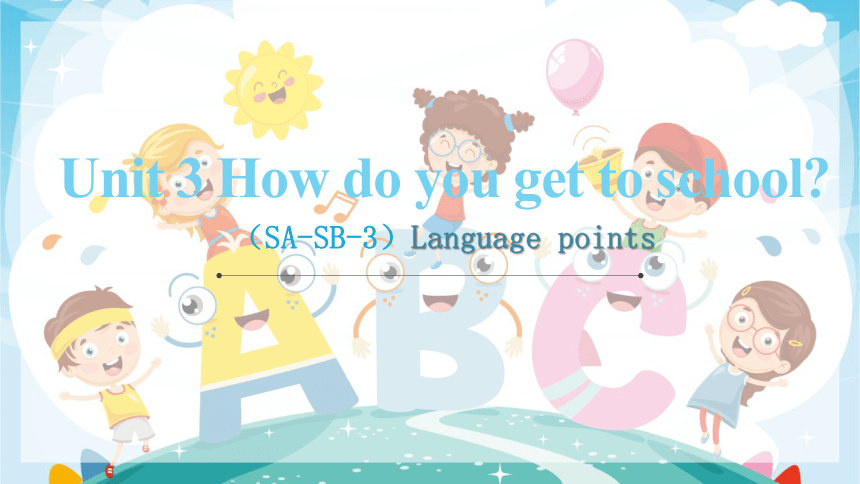 | |
| 格式 | zip | ||
| 文件大小 | 2.0MB | ||
| 资源类型 | 教案 | ||
| 版本资源 | 人教新目标(Go for it)版 | ||
| 科目 | 英语 | ||
| 更新时间 | 2022-08-16 16:22:06 | ||
图片预览

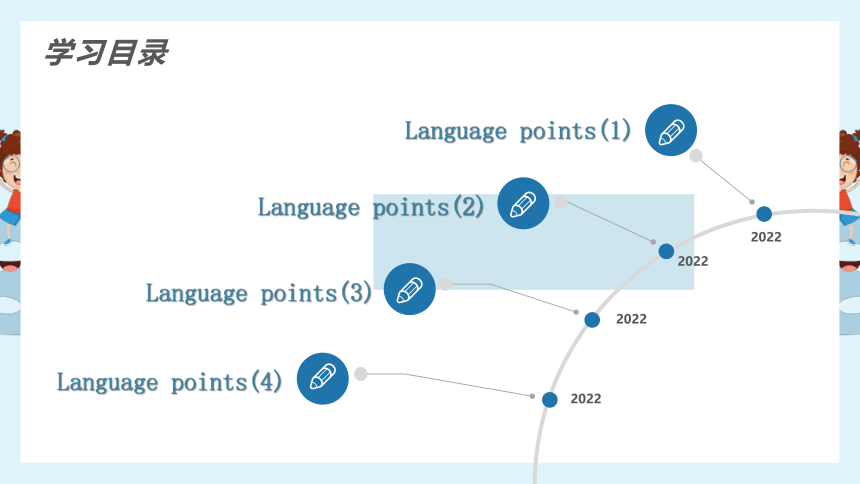
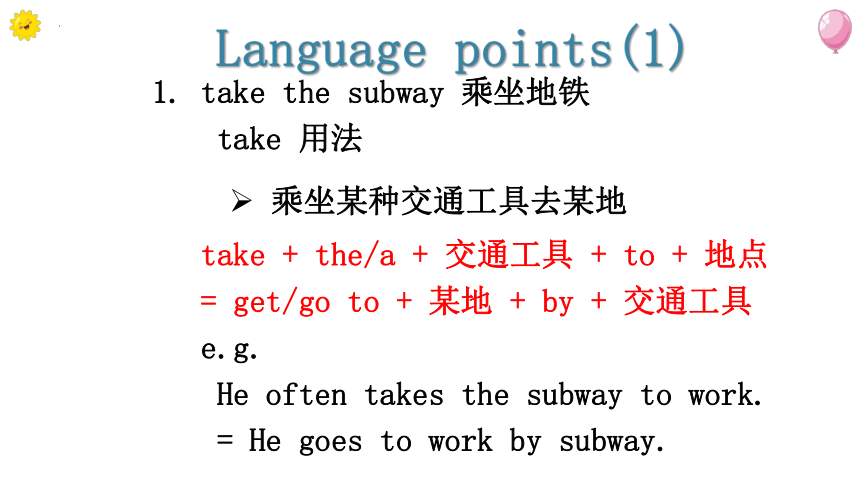
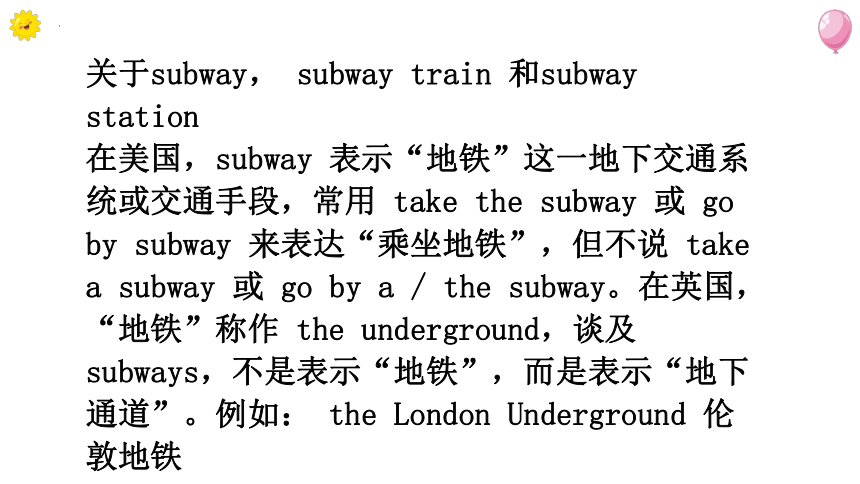
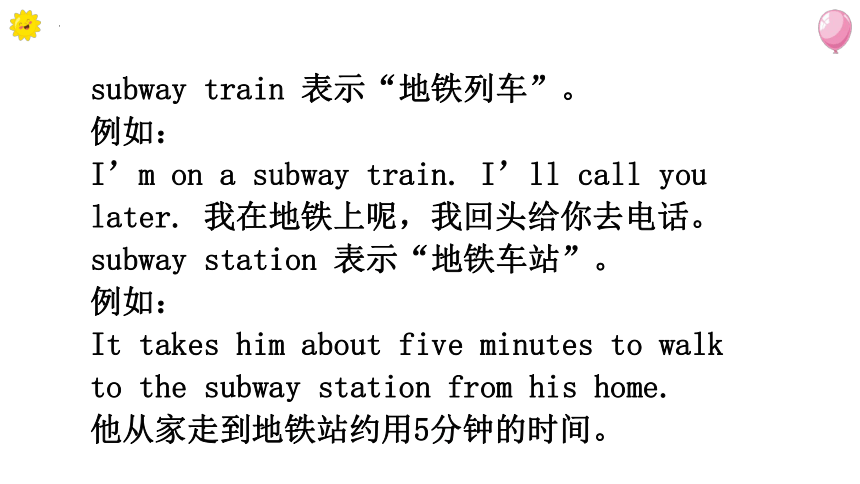
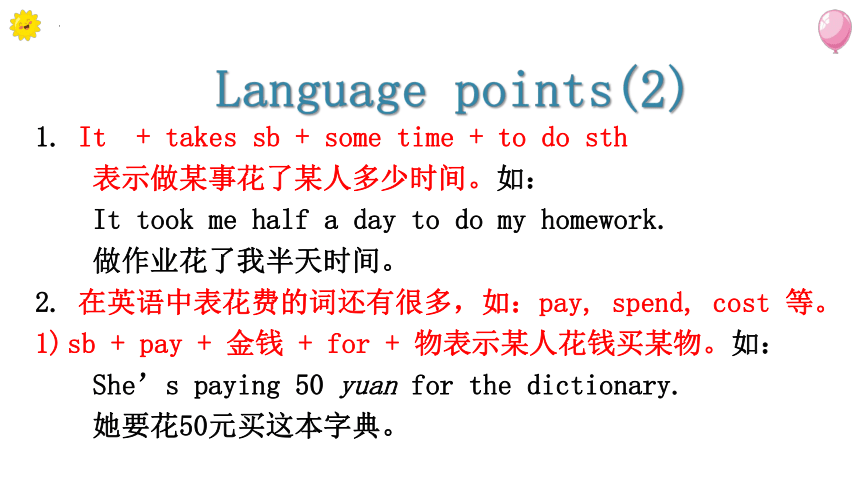
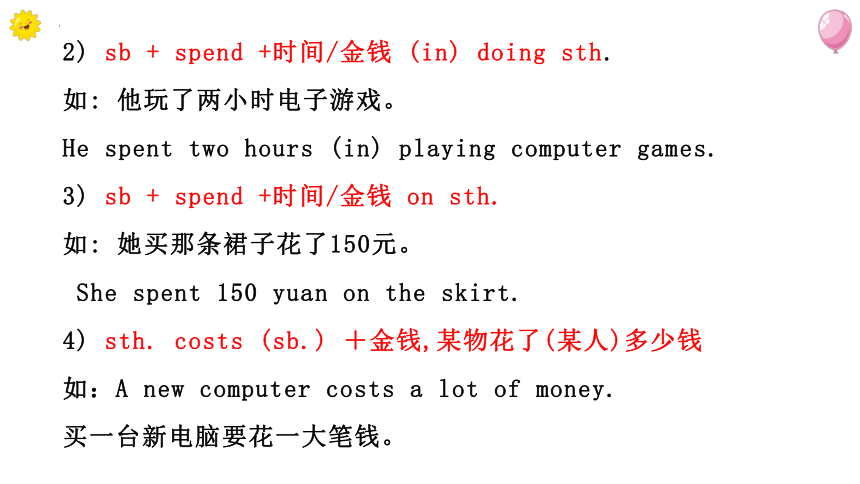
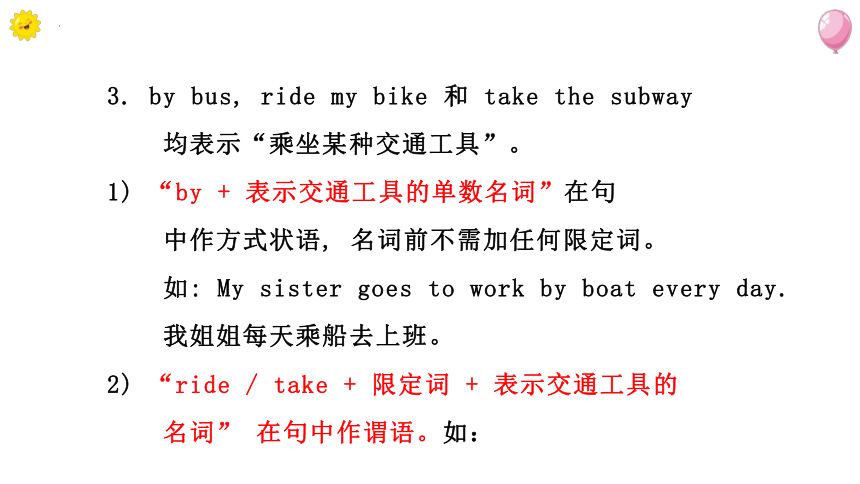
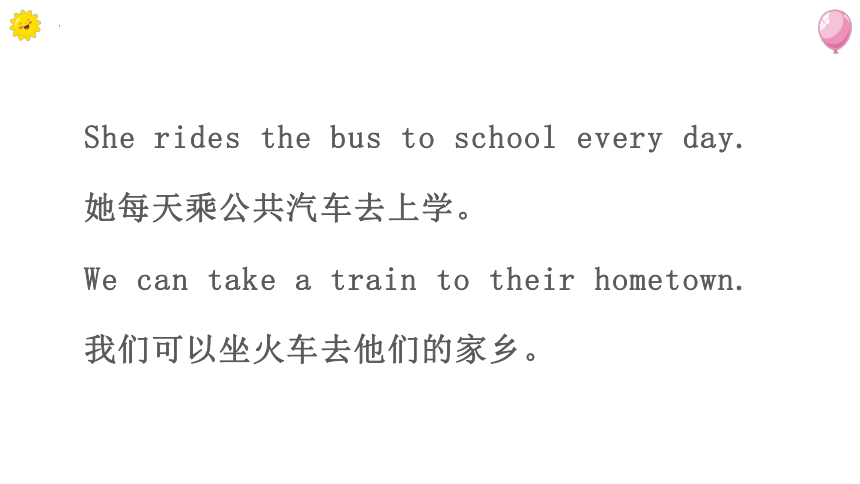
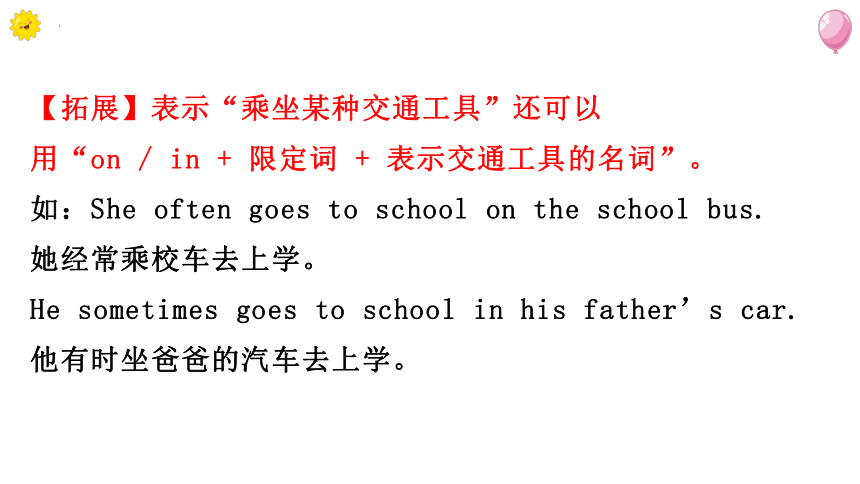
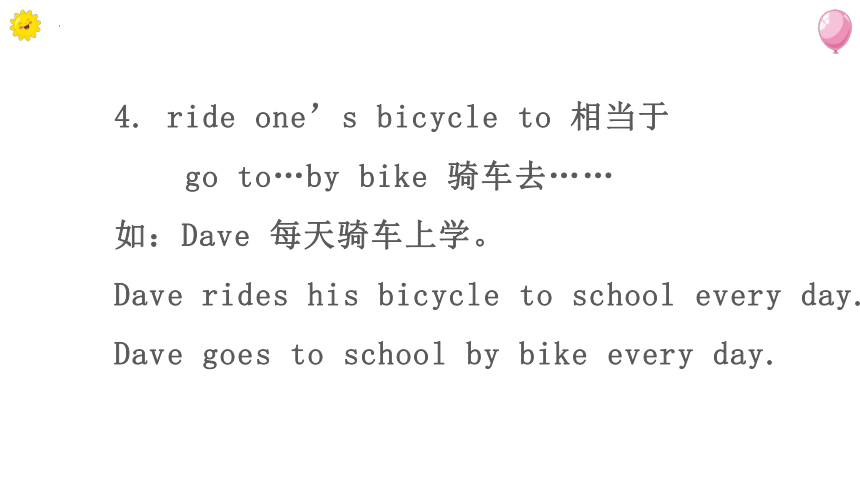
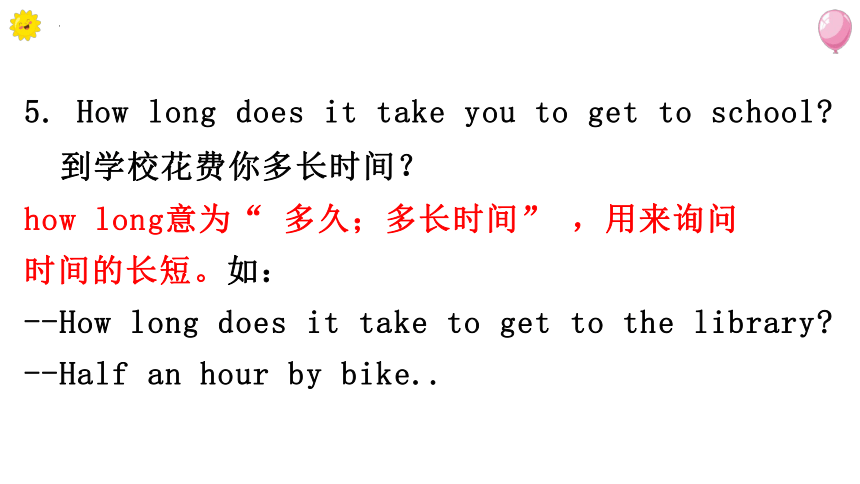
文档简介
(共46张PPT)
Unit 3 How do you get to school
(SA-SB-3)Language points
学习目录
2022
2022
2022
2022
Language points(2)
Language points(1)
Language points(3)
Language points(4)
乘坐某种交通工具去某地
take + the/a + 交通工具 + to + 地点
= get/go to + 某地 + by + 交通工具
e.g.
He often takes the subway to work.
= He goes to work by subway.
take the subway 乘坐地铁
take 用法
Language points(1)
关于subway, subway train 和subway station
在美国,subway 表示“地铁”这一地下交通系统或交通手段,常用 take the subway 或 go by subway 来表达“乘坐地铁”,但不说 take a subway 或 go by a / the subway。在英国,“地铁”称作 the underground,谈及 subways,不是表示“地铁”,而是表示“地下通道”。例如: the London Underground 伦敦地铁
subway train 表示“地铁列车”。
例如:
I’m on a subway train. I’ll call you later. 我在地铁上呢,我回头给你去电话。
subway station 表示“地铁车站”。
例如:
It takes him about five minutes to walk to the subway station from his home. 他从家走到地铁站约用5分钟的时间。
1. It + takes sb + some time + to do sth
表示做某事花了某人多少时间。如:
It took me half a day to do my homework.
做作业花了我半天时间。
2. 在英语中表花费的词还有很多,如:pay, spend, cost 等。
sb + pay + 金钱 + for + 物表示某人花钱买某物。如:
She’s paying 50 yuan for the dictionary.
她要花50元买这本字典。
Language points(2)
2) sb + spend +时间/金钱 (in) doing sth.
如: 他玩了两小时电子游戏。
He spent two hours (in) playing computer games.
3) sb + spend +时间/金钱 on sth.
如: 她买那条裙子花了150元。
She spent 150 yuan on the skirt.
4) sth. costs (sb.) +金钱,某物花了(某人)多少钱
如:A new computer costs a lot of money.
买一台新电脑要花一大笔钱。
3. by bus, ride my bike 和 take the subway
均表示“乘坐某种交通工具”。
1) “by + 表示交通工具的单数名词”在句
中作方式状语, 名词前不需加任何限定词。
如: My sister goes to work by boat every day.
我姐姐每天乘船去上班。
2) “ride / take + 限定词 + 表示交通工具的
名词” 在句中作谓语。如:
She rides the bus to school every day.
她每天乘公共汽车去上学。
We can take a train to their hometown.
我们可以坐火车去他们的家乡。
【拓展】表示“乘坐某种交通工具”还可以
用“on / in + 限定词 + 表示交通工具的名词”。
如:She often goes to school on the school bus.
她经常乘校车去上学。
He sometimes goes to school in his father’s car.
他有时坐爸爸的汽车去上学。
4. ride one’s bicycle to 相当于
go to…by bike 骑车去……
如:Dave 每天骑车上学。
Dave rides his bicycle to school every day.
Dave goes to school by bike every day.
5. How long does it take you to get to school
到学校花费你多长时间?
how long意为“ 多久;多长时间” ,用来询问
时间的长短。如:
--How long does it take to get to the library
--Half an hour by bike..
【拓展】
how long 还可表示“ 多长” ,用来询问物品的长度。如:
— How long is this river
— It’s about 150 kilometers.
get to“到达”,后跟地点名词。
如: get to the south of Italy
若get to 后的地点是副词,则省to。
get home get there get here
6. How far is it from your home to school
how far意为“多远”,用来询问距离,常用
“数词+kilometers/miles”或“ 时间段的所有格形式+drive/ride”等来回答。如:
-- How far is your home from the train
station
-- About fifteen minutes’ drive.
关于 how 的用法
how adv. 指范围、程度、数量、价值等的“多少、多么”。
用于疑问句中,表示身体怎样。
How is your brother
你哥哥身体好吗?
2) 用于疑问句中,表示多少、什么程度。
How old is he 他多大年纪?
【总结】
How much baggage am I allowed to take
我可以带多少行李?
I don’t know how far to rely on him.
我不知道应该依靠他到什么程度。
How far is it from your home to school
你家离学校有多远?
How is the U.S. dollar today
今天美元市价多少?
How long does it take you to get from home to school
你从家到学校要多久?
3)(指方式、方法)怎样,怎么
How did you climb to the top of that building
你是如何爬上楼顶的?
How do you get to school
你是如何去学校的?
4) 用于惊叹句中,表示多么……
How well you look!
你看起来多么健康啊!
How I wish to have a long vacation
these days!
这些天我多么希望去度一次长假啊!
1. How do/does + 某人 + ___________
某人怎么去某地?
how是疑问副词, 本句中用来提问__________ 等。
你叔叔怎样去香港?
__________________________
探究乐园
出行方式
get to+ 某地
How does your uncle get to Hong Kong
2. 回答方式有两种:
A: 某人 + take(s) + ____________ + to 某地。
B: 某人 + get(s) to 某地 + _____________
我叔叔乘飞机去香港。
___________________________________
___________________________________
the 交通工具
by 交通工具
My uncle takes the plane to Hong Kong.
My uncle gets to Hong Kong by plane.
3. It takes sb. some time to do sth.
意为:___________________________
步行大约要花我15 分钟的时间。
_________________________________
做作业大约花费简30分钟的时间。
________________________________
It takes me about 15 minutes to walk.
It takes Jane 30 minutes to do her homework.
某事花费某人……时间
4. 如果对时间段提问的话,就用
_________ + does it take sb. to do sth. 句型。
How long
How long does it take to walk to school
How long does it take to do her homework
5. 对两地间的距离提问下列句型:
_______ + is it _____ 某地 ___ 某地?
从他家到服装店多远?
_______ is it _____ his home __ the
clothes store
从北京到上海有多远?
_______ is __ from Beijing ___ Shanghai
How far
from to
to
How far it
How far
from to
How do you get to school
你是怎么上学去的?
how 是疑问副词, 通常用来提问方式等。
含有动词交通方式有:
take the subway take the train
walk (go on foot) take the bus …
可以用介词by表示乘坐方式
by bus, by subway, by ship, by bike, by plane/air
Language points(3)
While-reading
How do you get to school Do you walk or ride a bike Do you go by
bus or by train For many students, it is easy to get to school. But for the students in one small village in China, it is difficult. There is a very big river between their school and the village. There is no bridge and the river runs too quickly for boats. So these students go on a ropeway to cross the river to school.
Crossing the River to School
/ meni/ adj.& pron.许多
for many students 对于许多学生来说
/ v l d / n.村庄;村镇
/ br d / n.桥
boat /b t / n.小船
STUDENT LIFE 2010-04-20
One 11-year-old boy, Liangliang, crosses the river every school day.
But he is not afraid because he loves school. “I love to play with my classmates. And I love my teacher. He’s like a father to me.”
Many of the students and villagers never leave the village. It is their dream to have a bridge. Can their dream come true
/j / /j r/ n. 年;岁
/ fre d/ adj. 害怕;畏惧
/la k/ prep. 像;怎么样
villager / v l d (r)/ n. 村民
/li v/ v. 离开;留下
/dri m/ n. 梦想;睡梦 v. 做梦
实现;成为现实
true /tru / adj. 真的;符合事实的
play with sb. 和某人玩耍
He rides his bike to school.
=He gets to school on his bike.
=He gets to school by bike.
How does he get to school
She walks to school.
=She goes to school on foot.
How does she get to school
总结:How 引导的特殊疑问句
1.用来询问方式或手段。
如:
— How does Li Lei usually go to school
— He usually goes to school by bus.
2.用来询问程度。
如:
— How is your weekend 周末过得怎样?
— How is your mother today 你妈妈今天身体好吗?
3. 【how long】
(1)询问时间长短
如:-- How long does it take you to go to work
by bike every day 你每天骑自行车上班花多长时间?
-- Half an hour. 半个小时。
(2)多用来询问长度。
如:How long is the Yellow River 黄河有多长?
4. 【 how far 】提问路程的长短。
如:—How far is it from your home to school
你家离学校有多远?
— About 2 kilometers. 大约2千米。
think of 认为
What does Bob think of the trip
鲍勃认为旅行怎么样?
【拓展】
What do/does sb. think of … 某人觉得……怎么样?
(= How do/does sb. like… )
How does Bob like the trip
Language points(4)
take 用法
1. take 表示“乘、坐”某一交通工具。如:
My father usually takes a bus to work.
我爸爸常乘公共汽车去上班。
Which bus do you often take
你经常乘哪一路公共汽车?
注意: take和 by都有“乘、坐”之意。take 是一个
动词,后面接具体的交通工具,且在表示该交通工具
的名词前一般应有冠词等修饰语; 而 by是一个介词,
它后面所跟的表示交通工具的名词前一般不可用
冠词等修饰语。by 短语在句中修饰动词等作状语。
如:格林先生经常乘火车去上班。
Mr. Green often goes to work by train.
Mr. Green often takes a train to work.
2. take 表示“花费时间”之意, 其常用句型为
“ It takes sb. some time to do sth. ”,
意为“某人花多少时间做某事”, 注意后面的
动词前的 to 不可丢掉。如:
It takes her twenty minutes to walk to
school every day.
她每天步行去上学要花二十分钟的时间。
It takes me half an hour to do my homework.
我要花半小时做作业。
3. 含 take 的短语
take exercise 运动; 锻炼 take a walk 散步
take a look (at) 看一看 take down 取下
take a seat 坐下,坐坐 take out 拿出
take a rest 休息
take away 拿走
take a vacation 度假
take off (脱掉;飞机等) 起飞
take photos 照相,拍照
4. There is a very big river between their school and the village.
there be侧重于客观存在的“有”,强调存在的状态。在there be结构中,主语应放在be动词之后,并且be动词的形式应与主语保持一致。
如:
There are many apples on the tree.
【拓展】
have侧重于主观方面,强调“所属” 关系,表示“拥有,占有,具有”。在这一结构中,have与主语保持人称和数的一致。
如:
She has a nice schoolbag.
between … and … 在……与……之间
between 是个介词,表示在两者之间。
如:
Mary is between Jane and Linda in the line.
在队伍中,玛丽在简和琳达之间。
5. There is no bridge and the river runs too
quickly for boats.
河上根本没有桥,而且水流很急,不适宜小船摆渡。
(1) no “完全不、根本没有”,在这里
构成否定句。当no 用于构成否定句,主要
用于名词前,强调否定其后面的名词。如:
There is no apple in the fridge.
冰箱里没有苹果了。
(2) run 在这里表示“液体流动”。
它在不同的语境中有不同的用法和含义。例如:
Who runs the business 生意是谁经营的
“run”表示 “管理;经营”
② John run a car into a park. 约翰把车开进了公园。
“run”表示 “使行驶;驾驶”
③ The road runs north.这条路伸向北方。
“run”表示 “延伸”
④ “run” 可以做名词 “奔跑,路程”
Let’s go for a run across the field.
咱们去跑步,跑过那片田野吧。
It is an hour’s run by train from here to London.
从此地到伦敦搭火车有一小时的行程。
6. One 11-year-old boy, Liangliang, crosses the
river every school day.
一个11岁的男孩—亮亮,每天过河上学 。
11-year-old 为多个词汇构成的复合形容词,用连
字符“-”连接,用来修饰名词 boy。这种结构还
有很多,例如:
a four-day trip 一个四天的旅行
a 30-page book 一本30页的书
注意:这里的“year,day,page”都是用单数。
7. But he is not afraid because he loves school.
afraid adj. 害怕;恐惧 ;
(1)be afraid...害怕的
The girl is very afraid. 小女孩很害怕。
(2)be afraid of … 害怕 ……
My sister is afraid of snakes.
我妹妹害怕蛇。
8. He’s like a father to me.
like 在这里作介词,而不是动词,意为“像”。
The fish looks like a big boat.
那条鱼看起来像条船 。(介词)
Jane likes history very much.
简很喜欢历史。 (动词)
谢谢观看
2022
Unit 3 How do you get to school
(SA-SB-3)Language points
学习目录
2022
2022
2022
2022
Language points(2)
Language points(1)
Language points(3)
Language points(4)
乘坐某种交通工具去某地
take + the/a + 交通工具 + to + 地点
= get/go to + 某地 + by + 交通工具
e.g.
He often takes the subway to work.
= He goes to work by subway.
take the subway 乘坐地铁
take 用法
Language points(1)
关于subway, subway train 和subway station
在美国,subway 表示“地铁”这一地下交通系统或交通手段,常用 take the subway 或 go by subway 来表达“乘坐地铁”,但不说 take a subway 或 go by a / the subway。在英国,“地铁”称作 the underground,谈及 subways,不是表示“地铁”,而是表示“地下通道”。例如: the London Underground 伦敦地铁
subway train 表示“地铁列车”。
例如:
I’m on a subway train. I’ll call you later. 我在地铁上呢,我回头给你去电话。
subway station 表示“地铁车站”。
例如:
It takes him about five minutes to walk to the subway station from his home. 他从家走到地铁站约用5分钟的时间。
1. It + takes sb + some time + to do sth
表示做某事花了某人多少时间。如:
It took me half a day to do my homework.
做作业花了我半天时间。
2. 在英语中表花费的词还有很多,如:pay, spend, cost 等。
sb + pay + 金钱 + for + 物表示某人花钱买某物。如:
She’s paying 50 yuan for the dictionary.
她要花50元买这本字典。
Language points(2)
2) sb + spend +时间/金钱 (in) doing sth.
如: 他玩了两小时电子游戏。
He spent two hours (in) playing computer games.
3) sb + spend +时间/金钱 on sth.
如: 她买那条裙子花了150元。
She spent 150 yuan on the skirt.
4) sth. costs (sb.) +金钱,某物花了(某人)多少钱
如:A new computer costs a lot of money.
买一台新电脑要花一大笔钱。
3. by bus, ride my bike 和 take the subway
均表示“乘坐某种交通工具”。
1) “by + 表示交通工具的单数名词”在句
中作方式状语, 名词前不需加任何限定词。
如: My sister goes to work by boat every day.
我姐姐每天乘船去上班。
2) “ride / take + 限定词 + 表示交通工具的
名词” 在句中作谓语。如:
She rides the bus to school every day.
她每天乘公共汽车去上学。
We can take a train to their hometown.
我们可以坐火车去他们的家乡。
【拓展】表示“乘坐某种交通工具”还可以
用“on / in + 限定词 + 表示交通工具的名词”。
如:She often goes to school on the school bus.
她经常乘校车去上学。
He sometimes goes to school in his father’s car.
他有时坐爸爸的汽车去上学。
4. ride one’s bicycle to 相当于
go to…by bike 骑车去……
如:Dave 每天骑车上学。
Dave rides his bicycle to school every day.
Dave goes to school by bike every day.
5. How long does it take you to get to school
到学校花费你多长时间?
how long意为“ 多久;多长时间” ,用来询问
时间的长短。如:
--How long does it take to get to the library
--Half an hour by bike..
【拓展】
how long 还可表示“ 多长” ,用来询问物品的长度。如:
— How long is this river
— It’s about 150 kilometers.
get to“到达”,后跟地点名词。
如: get to the south of Italy
若get to 后的地点是副词,则省to。
get home get there get here
6. How far is it from your home to school
how far意为“多远”,用来询问距离,常用
“数词+kilometers/miles”或“ 时间段的所有格形式+drive/ride”等来回答。如:
-- How far is your home from the train
station
-- About fifteen minutes’ drive.
关于 how 的用法
how adv. 指范围、程度、数量、价值等的“多少、多么”。
用于疑问句中,表示身体怎样。
How is your brother
你哥哥身体好吗?
2) 用于疑问句中,表示多少、什么程度。
How old is he 他多大年纪?
【总结】
How much baggage am I allowed to take
我可以带多少行李?
I don’t know how far to rely on him.
我不知道应该依靠他到什么程度。
How far is it from your home to school
你家离学校有多远?
How is the U.S. dollar today
今天美元市价多少?
How long does it take you to get from home to school
你从家到学校要多久?
3)(指方式、方法)怎样,怎么
How did you climb to the top of that building
你是如何爬上楼顶的?
How do you get to school
你是如何去学校的?
4) 用于惊叹句中,表示多么……
How well you look!
你看起来多么健康啊!
How I wish to have a long vacation
these days!
这些天我多么希望去度一次长假啊!
1. How do/does + 某人 + ___________
某人怎么去某地?
how是疑问副词, 本句中用来提问__________ 等。
你叔叔怎样去香港?
__________________________
探究乐园
出行方式
get to+ 某地
How does your uncle get to Hong Kong
2. 回答方式有两种:
A: 某人 + take(s) + ____________ + to 某地。
B: 某人 + get(s) to 某地 + _____________
我叔叔乘飞机去香港。
___________________________________
___________________________________
the 交通工具
by 交通工具
My uncle takes the plane to Hong Kong.
My uncle gets to Hong Kong by plane.
3. It takes sb. some time to do sth.
意为:___________________________
步行大约要花我15 分钟的时间。
_________________________________
做作业大约花费简30分钟的时间。
________________________________
It takes me about 15 minutes to walk.
It takes Jane 30 minutes to do her homework.
某事花费某人……时间
4. 如果对时间段提问的话,就用
_________ + does it take sb. to do sth. 句型。
How long
How long does it take to walk to school
How long does it take to do her homework
5. 对两地间的距离提问下列句型:
_______ + is it _____ 某地 ___ 某地?
从他家到服装店多远?
_______ is it _____ his home __ the
clothes store
从北京到上海有多远?
_______ is __ from Beijing ___ Shanghai
How far
from to
to
How far it
How far
from to
How do you get to school
你是怎么上学去的?
how 是疑问副词, 通常用来提问方式等。
含有动词交通方式有:
take the subway take the train
walk (go on foot) take the bus …
可以用介词by表示乘坐方式
by bus, by subway, by ship, by bike, by plane/air
Language points(3)
While-reading
How do you get to school Do you walk or ride a bike Do you go by
bus or by train For many students, it is easy to get to school. But for the students in one small village in China, it is difficult. There is a very big river between their school and the village. There is no bridge and the river runs too quickly for boats. So these students go on a ropeway to cross the river to school.
Crossing the River to School
/ meni/ adj.& pron.许多
for many students 对于许多学生来说
/ v l d / n.村庄;村镇
/ br d / n.桥
boat /b t / n.小船
STUDENT LIFE 2010-04-20
One 11-year-old boy, Liangliang, crosses the river every school day.
But he is not afraid because he loves school. “I love to play with my classmates. And I love my teacher. He’s like a father to me.”
Many of the students and villagers never leave the village. It is their dream to have a bridge. Can their dream come true
/j / /j r/ n. 年;岁
/ fre d/ adj. 害怕;畏惧
/la k/ prep. 像;怎么样
villager / v l d (r)/ n. 村民
/li v/ v. 离开;留下
/dri m/ n. 梦想;睡梦 v. 做梦
实现;成为现实
true /tru / adj. 真的;符合事实的
play with sb. 和某人玩耍
He rides his bike to school.
=He gets to school on his bike.
=He gets to school by bike.
How does he get to school
She walks to school.
=She goes to school on foot.
How does she get to school
总结:How 引导的特殊疑问句
1.用来询问方式或手段。
如:
— How does Li Lei usually go to school
— He usually goes to school by bus.
2.用来询问程度。
如:
— How is your weekend 周末过得怎样?
— How is your mother today 你妈妈今天身体好吗?
3. 【how long】
(1)询问时间长短
如:-- How long does it take you to go to work
by bike every day 你每天骑自行车上班花多长时间?
-- Half an hour. 半个小时。
(2)多用来询问长度。
如:How long is the Yellow River 黄河有多长?
4. 【 how far 】提问路程的长短。
如:—How far is it from your home to school
你家离学校有多远?
— About 2 kilometers. 大约2千米。
think of 认为
What does Bob think of the trip
鲍勃认为旅行怎么样?
【拓展】
What do/does sb. think of … 某人觉得……怎么样?
(= How do/does sb. like… )
How does Bob like the trip
Language points(4)
take 用法
1. take 表示“乘、坐”某一交通工具。如:
My father usually takes a bus to work.
我爸爸常乘公共汽车去上班。
Which bus do you often take
你经常乘哪一路公共汽车?
注意: take和 by都有“乘、坐”之意。take 是一个
动词,后面接具体的交通工具,且在表示该交通工具
的名词前一般应有冠词等修饰语; 而 by是一个介词,
它后面所跟的表示交通工具的名词前一般不可用
冠词等修饰语。by 短语在句中修饰动词等作状语。
如:格林先生经常乘火车去上班。
Mr. Green often goes to work by train.
Mr. Green often takes a train to work.
2. take 表示“花费时间”之意, 其常用句型为
“ It takes sb. some time to do sth. ”,
意为“某人花多少时间做某事”, 注意后面的
动词前的 to 不可丢掉。如:
It takes her twenty minutes to walk to
school every day.
她每天步行去上学要花二十分钟的时间。
It takes me half an hour to do my homework.
我要花半小时做作业。
3. 含 take 的短语
take exercise 运动; 锻炼 take a walk 散步
take a look (at) 看一看 take down 取下
take a seat 坐下,坐坐 take out 拿出
take a rest 休息
take away 拿走
take a vacation 度假
take off (脱掉;飞机等) 起飞
take photos 照相,拍照
4. There is a very big river between their school and the village.
there be侧重于客观存在的“有”,强调存在的状态。在there be结构中,主语应放在be动词之后,并且be动词的形式应与主语保持一致。
如:
There are many apples on the tree.
【拓展】
have侧重于主观方面,强调“所属” 关系,表示“拥有,占有,具有”。在这一结构中,have与主语保持人称和数的一致。
如:
She has a nice schoolbag.
between … and … 在……与……之间
between 是个介词,表示在两者之间。
如:
Mary is between Jane and Linda in the line.
在队伍中,玛丽在简和琳达之间。
5. There is no bridge and the river runs too
quickly for boats.
河上根本没有桥,而且水流很急,不适宜小船摆渡。
(1) no “完全不、根本没有”,在这里
构成否定句。当no 用于构成否定句,主要
用于名词前,强调否定其后面的名词。如:
There is no apple in the fridge.
冰箱里没有苹果了。
(2) run 在这里表示“液体流动”。
它在不同的语境中有不同的用法和含义。例如:
Who runs the business 生意是谁经营的
“run”表示 “管理;经营”
② John run a car into a park. 约翰把车开进了公园。
“run”表示 “使行驶;驾驶”
③ The road runs north.这条路伸向北方。
“run”表示 “延伸”
④ “run” 可以做名词 “奔跑,路程”
Let’s go for a run across the field.
咱们去跑步,跑过那片田野吧。
It is an hour’s run by train from here to London.
从此地到伦敦搭火车有一小时的行程。
6. One 11-year-old boy, Liangliang, crosses the
river every school day.
一个11岁的男孩—亮亮,每天过河上学 。
11-year-old 为多个词汇构成的复合形容词,用连
字符“-”连接,用来修饰名词 boy。这种结构还
有很多,例如:
a four-day trip 一个四天的旅行
a 30-page book 一本30页的书
注意:这里的“year,day,page”都是用单数。
7. But he is not afraid because he loves school.
afraid adj. 害怕;恐惧 ;
(1)be afraid...害怕的
The girl is very afraid. 小女孩很害怕。
(2)be afraid of … 害怕 ……
My sister is afraid of snakes.
我妹妹害怕蛇。
8. He’s like a father to me.
like 在这里作介词,而不是动词,意为“像”。
The fish looks like a big boat.
那条鱼看起来像条船 。(介词)
Jane likes history very much.
简很喜欢历史。 (动词)
谢谢观看
2022
同课章节目录
- Unit 1 Can you play the guitar?
- Section A
- Section B
- Unit 2 What time do you go to school?
- Section A
- Section B
- Unit 3 How do you get to school?
- Section A
- Section B
- Unit 4 Don't eat in class.
- Section A
- Section B
- Unit 5 Why do you like pandas?
- Section A
- Section B
- Unit 6 I'm watching TV.
- Section A
- Section B
- Review of Units 1-6
- Unit 7 It's raining!
- Section A
- Section B
- Unit 8 Is there a post office near here?
- Section A
- Section B
- Unit 9 What does he look like?
- Section A
- Section B
- Unit 10 I'd like some noodles.
- Section A
- Section B
- Unit 11 How was your school trip?
- Section A
- Section B
- Unit 12 What did you do last weekend?
- Section A
- Section B
